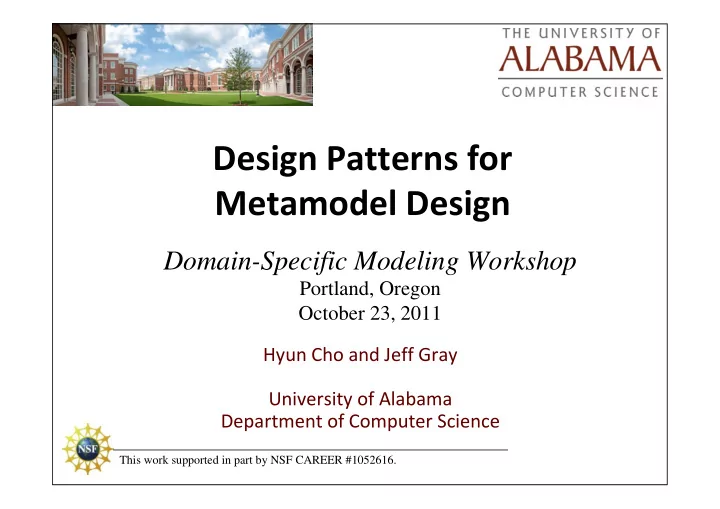

Design Patterns for Metamodel Design Domain-Specific Modeling Workshop Portland, Oregon October 23, 2011 Hyun Cho and Jeff Gray University of Alabama Department of Computer Science This work supported in part by NSF CAREER #1052616.
Domain-Specific Modeling Languages 2 � Customized to a specific domain � Designed and implemented by domain-driven needs and abstractions � Components of a DSML
Domain-Specific Modeling Languages (cont.) 3 � Benefits of DSMLs � Easier to learn and provide rich expressiveness � Evidence that DSMLs increase productivity and improve quality � Several success stories, but not widespread adoption � What is the reason? Perceived reasons by some: � High development cost and complex development process � Lack of vendor support � Lack of robustness � Lack of standardization � Requires both domain knowledge and language development expertise The quality of DSMLs largely depends on a designer’s domain experiences and language development expertise
Research Hypothesis 4 � Metamodels Metamodels can be designed (or inferred) by can be designed (or inferred) by � reusing existing metamodel concepts that represent that represent reusing existing metamodel concepts commonly recurring metamodel design issues commonly recurring metamodel design issues across multiple domains. across multiple domains. � Such reuse of metamodeling experience may Such reuse of metamodeling experience may � improve the quality of metamodel design as well as improve the quality of metamodel design as well as achieve a significant increase in productivity in the achieve a significant increase in productivity in the development of DSMLs. development of DSMLs.
Approach for Identifying Metamodel Design Patterns 5 � Collect various types of DSMLs � Identify characteristics of DSML and its modeling elements � Analyze commonality of DSMLs � Identify candidate metamodel design problems � Collect and review metamodel samples � Propose metamodel design patterns
Collection of DSMLs Examined 6 Domain Diagrams Brief Description Concurrent Discrete Modeling systems with concurrency and resource Event System Modeling Petri Net sharing Data Modeling ERD Model the logical structure of database Model project activities with relevant information (i.e., Gantt Chart duration, cost, …) Project Management Identify the critical path of the project by modeling the PERT Chart sequence of tasks Represent how electronic components are connected Schematic Diagram with others Electronic Circuit Design Show the placement of electronic components on PCB Layout printed circuit board Molecular Modeling - Model the structures and reactions of molecules Flowchart Model process or algorithm Component Diagram Represent static structure of components and their relations SW Design Describe system functionalities or behaviors with UseCase Diagram UseCase and Actor Describe the static structure of the system in terms of Class Diagram classes
Identify Characteristics of DSMLs 7 � Context Diagram Entity (Classifier) Relationship
Identify characteristics of DSMLs 8 � Electronic Circuit Design: Palm III Charger Schematic Diagram PCB Layout Diagram Images are copied from http://www.harbaum.org/till/palm/cradle/index.html
Identify characteristics of DSMLs (cont.) 9 � Component Diagram UML 1.x UML 2.x Images are copied from http://www.agilemodeling.com/artifacts/componentDiagram.htm
Identify characteristics of DSMLs (cont.) 10 � Component Diagram Image is copied from http://blogs.uis.edu/group8/files/2011/07/800px-Policy_Admin_Component_Diagram.png
Identify characteristics of DSMLs (cont.) 11 � UseCase Diagram Image is copied from http://www.agilemodeling.com/artifacts/useCaseDiagram.htm
Features of DSMLs 12
Questions for Identifying Candidate Patterns 13 � What could be a primitive or base metamodel pattern, which could be common ground for metamodel design? � How to extend the base metamodel if a DSML has complicated language constructs? � For example, a DSML can have typed relationships such as include and extend in UseCase diagram? � How to represent boundedness in metamodel? � How to design the metamodel to describe containment and nesting ?
References for Metamodel Design 14 � OMG UML 2 Superstructure, http://www.omg.org/spec/UML/2.3/Superstructure/PDF � OMG Business Process Model And Notation (BPMN) Ver. 2.0, http://www.omg.org/spec/BPMN/2.0 � QImPrESS Service Architecture Meta-Model, http://www.q-impress.eu/wordpress/wp-content/uploads/2009/05/d21- service_architecture_meta-model.pdf � Ouardani, A., Esteban, P., Paludetto, M., & Pascal, J. C. 2006. A Meta-modeling Approach for Sequence Diagrams to Petri Nets Transformation within the requirements validation process. In Proceedings of the European Simulation and Modeling Conference, pp. 345-349, Toulouse, France � Web Pages
Base Metamodel Pattern 15 � What could be a primitive or base metamodel pattern, which could be common ground for metamodel design? � How to represent boundedness in metamodel? � Applicable for simple Box-and-Line style DSMLs � Most common pattern for early stage of DSML development � Useful for Prototyping DSML � Evaluation Points � none
Metamodel with (sub)types Pattern 16 � How to extend the base metamodel if a DSML has complicated language constructs? � Extension of base metamodel design pattern � Add more expressiveness to DSMLs � Semantics of each relationship is required to enforce behaviors and properties � Evaluation Point � Association point between Classifiers and Relationships
Containment/Nesting Pattern 17 � How to design the metamodel to describe containment and nesting ? � Some DSMLs may contain or nest modeling elements to control the abstraction level � Can focus on core thoughts by eliminating unnecessary details or give more descriptions by showing details ��������� ����� ������� � Evaluation Point � Comprehensibility and Extendibility
Application of Metamodel Design Patterns 18 � Composition-based metamodel development ���������� � � � � ������ ������ ������ � ������ � ������� ������ ������������ Classifier Containment Typed Relationship
Application of Metamodel Design Patterns 19 � Metamodel Inference � Metamodel can be inferred from a set of model examples through grammar inference � To infer accurate metamodel, a large set of domain examples, both positive and negative examples � But, preparing a large set of domain examples are practically difficult � Metamodel design patterns can be used as a common sample data
Expected benefits of Metamodel Design Patterns 20 � Avoid duplication of metamodel design for recurring design problems � Keep high quality metamodel fragments � Guide and Recognize key patterns and best- practices of metamodel design � Reduce time-to-market for developing new DSMLs
Thank you for your attention 21 This work supported in part by NSF CAREER #1052616.
Recommend
More recommend